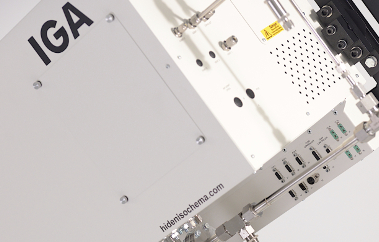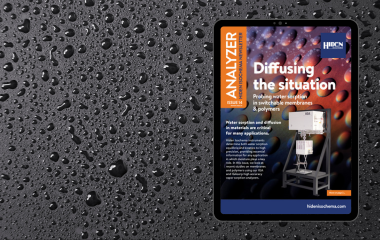In the Journal of the American Chemical Society, Stylianou et al have reported on the investigation of the structural transformation of a Zn-based flexible
Recent publications using XEMIS gas sorption analyzers
Characterizing gas interactions with MOFs, polymers and carbons using XEMIS gas sorption analyzers
Recent publications describe results of gas sorption measurements using XEMIS sorption analyzers in three topical areas; adsorption-induced structural changes in metal-organic frameworks (MOFs), gas transport and separation in polymers, and a novel route to porous carbons using waste material.
Control of adsorption-induced structural changes in MOFs
In a recent CrystEngComm publication, researchers at China University of Petroleum describe the effect of three different synthetic methods for the MOF MIL-53(Al), to yield crystals with different particle sizes [1]. The aim of the study was to control the gas adsorption induced ‘breathing effect’ of the MOF, as the material undergoes a change from its narrow pore to large pore structure. Crystals were prepared with varying amounts of alternative ligand, using a moderative hydrolysis method, and characterized by SEM (for particle size) and gas adsorption (for surface area and CO2 adsorption capacity, reversibility, and quantification of the adsorption-induced breathing effect. A XEMIS-001 was used to record adsorption-desorption isotherms for the various MOFs, with clear changes in the breathing effect for the different MOFs demonstrated by the isotherms. The authors comment that the gravimetric gas sorption technique is ideal for detailed characterization of the breathing effect.
Gas solubility and diffusivity in polymer membranes
A collaboration between National University of Singapore and BASF, Germany, reports the gas transport properties of several polyethersulfone polymers with differing chemical structures [2]. The gas separation polymers were characterized with a range of techniques, including wide angle X-ray scattering, gas permeation, and gas solubility and diffusion measurements. Following the structural studies, O2, N2, CO2 and CH4 permeation properties were measured, and a XEMIS-001 used to determine measure CO2 and CH4 gas sorption (solubility) in the membranes. The CO2 and CH4 isotherms were analysed using a dual mode (Henry and Langmuir) sorption model, and further analysed together with the permeation data to yield the gas diffusivity in the respective polymers. The study provides a more complete understanding of the solution-diffusion mechanism and provides an insight into future possibilities for molecular-level design of polyethersulfone polymers for gas separation applications.
Gas storage by porous carbons from waste cigarette filters
Scientists at the University of Nottingham, UK, describe an intriguing use of an abundant waste product to synthesise a useful material with impressive energy gas storage capacity [3]. Discarded (smoked) cigarette filters or butts are a non-trivial source of waste, containing heavy metal contaminants, as well as being a common source of litter. The paper describes a hydrothermal carbonisation synthesis, using both fresh and smoked filters as a starting material, yielding porous carbons with high oxygen content, high surface area and high microporosity. Significantly, the carbons also exhibit unprecedentedly high hydrogen storage capacity for a carbon at 77 K. A XEMIS-003 was used to measure hydrogen adsorption isotherms for the various carbons, which was then compared to equivalent data for a selection of MOFs. The high gas uptake values observed for the carbons compares favourably to the best performing MOFs, despite the latter’s greater surface area. The authors then discuss the role of both surface area and oxygen heteroatom content on the hydrogen adsorption capacity of the carbons, with reference to an earlier study also using a XEMIS-003 [4].
These recent publications demonstrate just some of the application areas where XEMIS sorption analyzers are contributing to research groups’ understanding of the properties of interesting new materials, even when only small quantities of material are available. With installations at sites across the Americas, Europe and Asia, XEMIS analyzers are recognized for their flexibility and for the quality of the data obtained. To discuss how Hiden Isochema’s gas and vapor sorption analyzers can help with your application, please get in touch or request a quote!
[1] D. Liu et al, CrystEngComm 2018, DOI: 10.1039/C8CE00050F
[2] A. Naderi et al, Polymer 2018, 135, 65
[3] T. S. Blankenship and R. Mokaya, Energy & Environmental Science 2017, 10, 2552
[4] T. S. Blankenship, N Balahmar and R. Mokaya, Nature Communications 2017, 8, 1545


